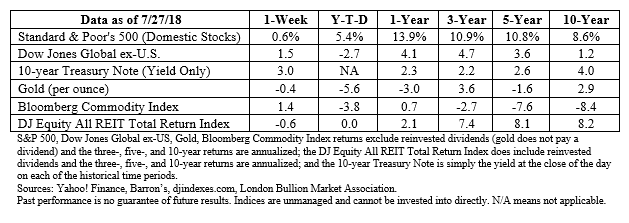The Markets
Is it a sugar rush or something more sustainable?
Economic growth in the United States was strong during the second quarter. Gross domestic product (GDP), which is the value of all goods and services produced in the United States, grew by 4.1 percent. That’s the fastest growth in four years, reported the BBC.
The news was received with varying levels of enthusiasm. President Trump said the gain is “an economic turnaround of historic importance” and thinks the economy should continue to grow rapidly, reported Shawn Donnan in Financial Times.
Economists were less certain. They think second quarter’s GDP gains were underpinned by one-time factors. These included high levels of profitability attributable to last year’s corporate tax cuts and an increase in exports as U.S. producers and their buyers abroad tried to avoid upcoming tariffs, reported Financial Times.
Another consideration is the business cycle. The business cycle tracks the rise and fall of a country’s productivity over time. The U.S. appears to be in the latter stages of the current cycle. John Authers of Financial Times explained:
“…President Donald Trump’s self-congratulation yesterday was fully merited. Things are going according to plan. This business cycle looks ever more like a normal one, which is a fantastic and welcome development after an epochal crisis and then a decade of doldrums…The advent of a normal cycle is itself a problem because a normal cycle terminates with high interest rates and declining growth. The president has voiced his disapproval of these things, but they are the logical and sensible consequence of the economic developments that are now unfolding.”
In the United States, the Dow Jones Industrial Average and the Standard & Poor’s 500 Index moved higher while the NASDAQ Composite gave up some ground.

IT’S CAMPING SEASON! In 1869, the first recreational camping guide, Adventures in Wilderness, was authored by minister William H.H. Murray and became a bestseller. The book’s success may have owed something to a new train route that made the Adirondacks more accessible. Time.com reported his practical guide offered advice on important topics:
“For sleeping, he describes how to make ‘a bed of balsam-boughs.’ On what to wear, he suggests bringing a ‘felt hat,’ ‘stout pantaloons,’ and a ‘rubber blanket or coat.’ For warding off woodchucks, ‘a stick, a piece of bark, or tin plate shied in the direction of the noise will scatter them like cats.’ As for wolves, his technique would likely not pass muster with fire wardens: ‘touch a match to an old stump and in two hours there will not be a wolf within ten miles of you.’”
His book inspired Kate Field to try camping, and she became an early advocate of land preservation. She wrote for the Adirondack Almanac in 1870. A more recent article in the publication reported:
“Field advised her readers to bring a tent rather than kill trees. ‘It is cruel to stab a tree to the heart merely to secure a small strip of bark,’ she said. ‘It is ungrateful to destroy the pine and balsam that have given us our beds of boughs, and fanned us with their vital breath. Let there be tents.’”
Additional advice can be found in Civil War veteran John M. Gould’s 1877 guide to backpacking, titled How To Camp Out. He warned against the allure of new gear:
“Do not be in a hurry to spend money on new inventions. Every year there is put upon the market some patent knapsack, folding stove, cooking-utensil, or camp trunk and cot combined; and there are always for sale patent knives, forks, and spoons all in one…Let them all alone: carry your pocket-knife…”
He might have been willing to make an exception for some of the gear available today!
Weekly Focus – Think About It
“Camping is nature’s way of promoting the motel business.” –Dave Barry, Humorist
Respectfully,
Brian M. Ursu, CFP(R)




